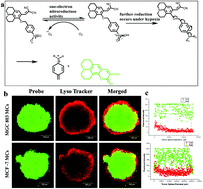Two-photon fluorescent probe for hypoxic cancer stem cells by responding to endogenous nitroreductase†
Abstract
Hypoxia is a fundamental feature of tumor formation, and it plays an important role in the maintenance of cancer cell growth. It has been proven that cancer stem cells (CSC) initiate tumor formation, recurrence, and metastasis. CSCs reside in a hypoxic microenvironment with high biological nitroreductase (NTR) levels, which are closely related to biological hypoxia status. Therefore, it is important to develop probes for detecting the levels of NTR in the tumor microenvironment of CSCs and destruction of the ‘soil’ of CSCs. Traditional NTR detection fluorescent probes are one-photon excited and need ultraviolet or visible light, which limits the application of probes in biomedical science because of poor tissue penetration. However, two-photon excited probes are more suitable for bioimaging due to the extended wavelength to near-infrared. In this study, we developed a two-photon fluorescent probe to detect NTR in 3D cultured-CSCs and monitor the hypoxic microenvironment in vitro. The two-photon fluorescent molecular probe with a hypoxic specific response group can be reduced by NTR under hypoxic conditions. This probe exhibited desirable characteristics such as high selectivity, no cytotoxicity, and a hypoxic fluorescence response. The probe can be applied for the detection of hypoxia status of tumour cells and tumour sphere cells. This novel probe has the potential to be applied to disease-relevant hypoxia detection in biomedical research.

- This article is part of the themed collection: Analytical Methods Recent HOT articles


 Please wait while we load your content...
Please wait while we load your content...